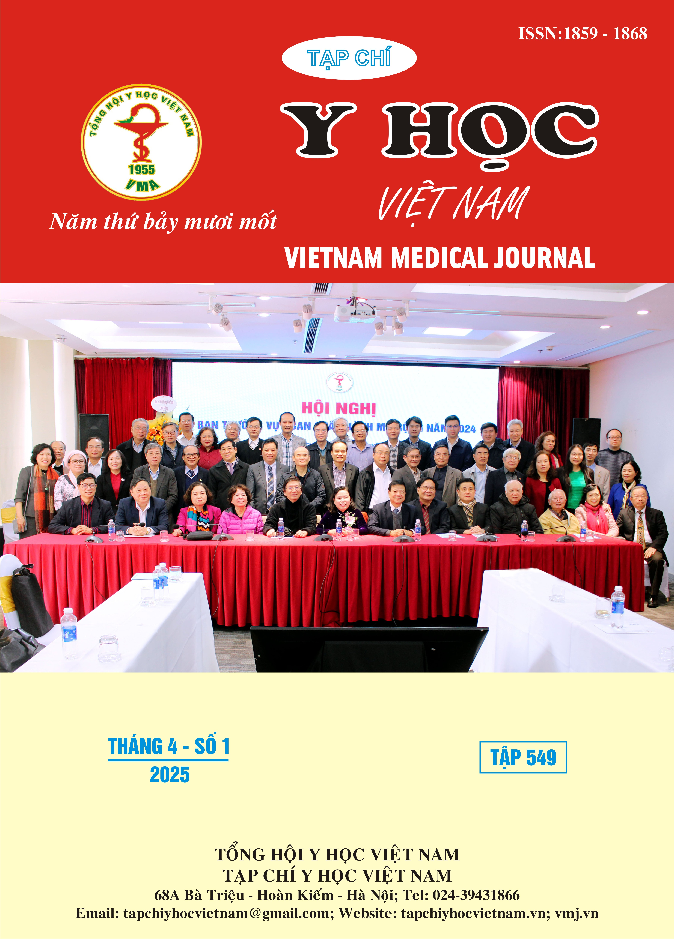KHẢO SÁT TỶ LỆ SANH NGẢ ÂM ĐẠO Ở SẢN PHỤ VỚI GÓC CỔ THÂN TỬ CUNG TỪ 90 ĐỘ KẾT HỢP CHỈ SỐ BISHOP TỪ 4 ĐIỂM VÀ CÁC YẾU TỐ LIÊN QUAN TẠI BỆNH VIỆN HÙNG VƯƠNG
Nội dung chính của bài viết
Tóm tắt
Mục tiêu: Xác định tỷ lệ sinh ngả âm đạo ở những sản phụ có góc cổ thân tử cung từ 90 độ kết hợp với điểm Bishop từ 4 điểm và các yếu tố liên quan tại bệnh viện Hùng Vương. Phương pháp nghiên cứu: Một nghiên cứu dọc tiền cứu có triển vọng gồm 335 trường hợp thai kỳ đơn thai đủ tháng bình thường, ngôi đầu, không có vết mổ cũ trên tử cung và không chống chỉ định sinh thường đã được phân tích. Kết quả: Tỷ lệ sinh ngả âm đạo thành công ở những sản phụ có góc tử cung 90 độ kết hợp với điểm Bishop từ 4 điểm là 87,2%. Các yếu tố liên quan đến sinh ngả âm đạo thành công sau khi phân tích hồi quy đa biến như sau: sinh con lần 2 có khả năng sinh ngả âm đạo thành công cao hơn với OR = 11,143; 95% CI [2,536 - 48,960]; p = 0,001. Độ lọt -2 có khả năng sinh ngả âm đạo thành công cao hơn so với -3 với OR = 3,564; 95% CI [1,458 – 8,715]; p = 0,005. Không tăng co với oxytocin khi tình trạng cổ tử cung không thuận lợi có khả năng sinh ngả âm đạo thành công cao hơn so với tăng co với oxytocin với OR = 2,605; 95% CI [1,108 – 6,129]; p = 0,028. Góc cổ tử cung lớn hơn có liên quan đến khả năng sinh thường thành công cao hơn với OR = 1,205; 95% CI [1,131 – 1,283]; p < 0,001. Vỡ màng ối sớm làm giảm khả năng sinh ngả âm đạo thành công, OR = 0,292; 95% CI [0,118 – 0,723]; p = 0,008. Kết luận: góc cổ thân tử cung từ 90 độ kết hợp với điểm Bishop từ 4 điểm có thể là một chỉ tố hiệu quả để dự đoán sinh ngả âm đạo thành công.
Chi tiết bài viết
Từ khóa
góc cổ thân tử cung, điểm bishop, dự đoán sinh ngả âm đạo, siêu âm trong chuyển dạ, giai đoạn I chuyển dạ
Tài liệu tham khảo
2. Yang SW, Kim SY, Hwang HS, Kim HS, Sohn IS, Kwon HS. The Uterocervical Angle Combined with Bishop Score as a Predictor for Successful Induction of Labor in Term Vaginal Delivery. J Clin Med. 2021;10(9):2033. doi:10.3390/jcm10092033
3. Nguyễn Thị Anh Phương, Huỳnh Nguyễn Khánh Trang. So sánh hiệu quả khởi phát chuyển dạ của thông Foley bóng đôi cải tiến và bóng đơn đặt kênh cổ tử cung ở thai trưởng thành tại Bệnh viện Hùng Vương. Tạp Chí Y Học Thành Phố Hồ Chí Minh. 2016;20(1):316-321.
4. Marconi AM, Manodoro S, Cipriani S, Parazzini F. Cesarean section rate is a matter of maternal age or parity? J Matern-Fetal Neonatal Med Off J Eur Assoc Perinat Med Fed Asia Ocean Perinat Soc Int Soc Perinat Obstet. 2022; 35 (15): 2972-2975. doi:10.1080/14767058. 2020.1803264
5. Braggion A, Favre G, Lepigeon K, Sichitiu J, Baud D, Desseauve D. Advanced Maternal Age Among Nulliparous at Term and Risk of Unscheduled Cesarean Delivery. Am J Obstet Gynecol MFM. 2023;5(8). doi:10.1016/j.ajogmf. 2023.100972
6. Ashwal E, Fan IY, Berger H, et al. The association between fetal head station at the first diagnosis of the second stage of labor and delivery outcomes. Am J Obstet Gynecol. 2021;224(3):306.e1-306.e8.
7. Ludvigsen E, Skjeldestad FE. Station of the fetal head at complete cervical dilation impacts duration of second stage of labor. Eur J Obstet Gynecol Reprod Biol X. 2020;7:100100. doi:10.1016/j.eurox.2019.100100
8. Taha OT, Elprince M, Atwa KA, Elgedawy AM, Ahmed AA, Khamees RE. Antenatal cervical length measurement as a predictor of successful vaginal birth. BMC Pregnancy Childbirth. 2020;20:191. doi:10.1186/s12884-020-02878-z


